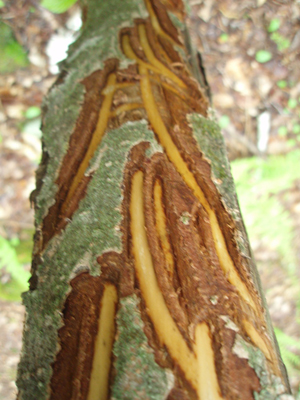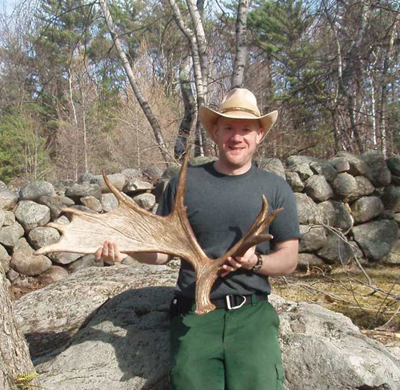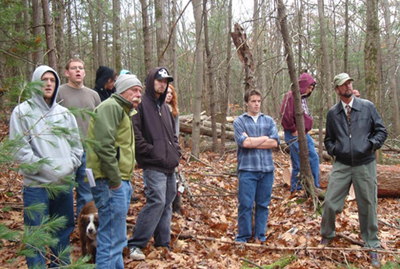Stewardship: Habitat Improvement at Fox Valley
Mount Grace Land Conservation Trust received a grant in 2009 from the United States Department of Agriculture’s Natural Resource Conservation Service to improve wildlife habitat at its Fox Valley Conservation Area on Lincoln Road in Phillipston.
Fox Valley is a 100-acre forest containing the headwaters of Popple Camp Brook. The conservation area is managed by Mount Grace Stewardship Biologist Tom Wansleben. While developing a 10 year forest stewardship plan, Wansleben and Forester Glenn Freden hoped to provide a more diverse wildlife habitat. They identified a 6 ½ acre portion of the valley, near the road, that was ideal for the creation of early successional and young forested habitat.
Early successional habitats are generally shrublands dominated by low woody vegetation with sparse tree cover and varying amounts of herbaceous plants. Young forested habitats are dominated by rapidly growing trees and shrubs, and generally occur when a mature forest canopy is disrupted, allowing sunlight to reach the forest floor. Both are prime habitat for bird species like the brown thrasher, blue-winged warbler, American woodcock, ruffed grouse, and eastern towhee.
The biggest threat to these “thicket” habitats is development. While early successional habitats included about 40% of Massachusetts forests in 1960, they now make up only 5%. The loss of thicket habitats and the species associated with them is detailed in MassWildlife’s 2005 Comprehensive Wildlife Conservation Strategy, which identifies these habitats as host to 21 species in need of conservation.
The full report (62MB) is available from the Massachusetts Department of Fisheries and Wildlife. The excerpted chapter on thicket habitat may be downloaded below.
To create thicket habitat, Freden conducted a clear cut sparing carefully chosen reserve trees. The cut removed 75%-90% of the tree canopy on 6.5 acres of the 100-acre forest stand while reserving biological legacies which are small groups or individual trees both live and dead. Examples of legacies that Freden and Wansleben kept are large mast producing trees like black cherry and oak along with some mature aspen, an important food source for ruffed grouse. Other retained legacies include large snags, some of which will be created by girdling live trees, and large downed logs which the logger purposefully left on site at the rate of one to three snags and downed logs per acre.
Keeping live trees, slash, downed logs, and snags on the land improves the recovery of the ecosystem after logging since they provide food resources, cover, and nesting sites for wildlife, and also form habitat for soil microbes that enrich the regenerating forest. By retaining these biological legacies, the cutting plan adds ecological complexity to the regenerating stand in comparison to traditional clear-cuts that create a homogeneous forest. Mount Grace will be conducting a long-term series of educational tours of the property to highlight best practices in managing forests for wildlife. Those interested in joining a tour can contact Outreach Coordinator Willa Caughey at 978-248-2055 x24 or outreach_americorps@mountgrace.org.
Doctor Tom Montagno’s Introduction to Natural Resource Conservation class at Mount Wachusett Community College attends a presentation on sustainable forestry at the Whitney Memorial Forest on Benjamin Hill in Winchendon. Forester Glenn Freden, who also conducted the habitat improvement cut at the Fox Valley Conservation Area, explained the current timber harvest and long term management plans. Whitney Memorial Forest was bequeathed to Mount Grace by Adelaide Whitney in 2000.



